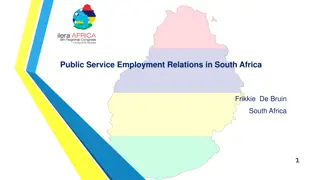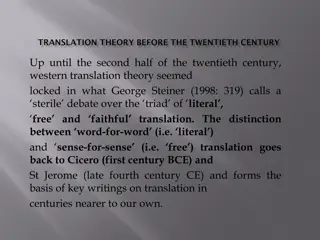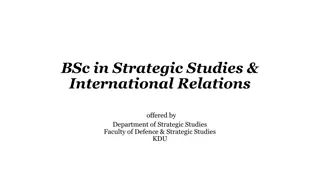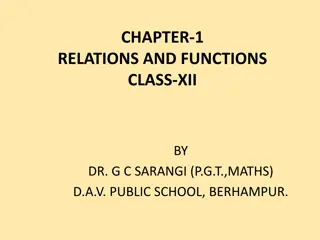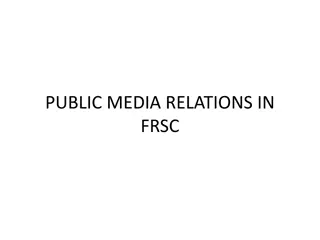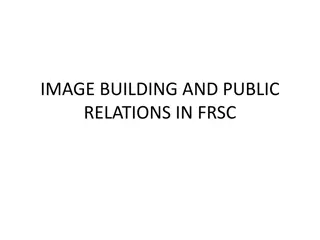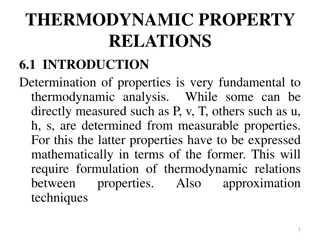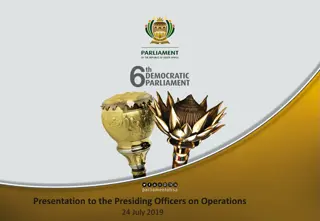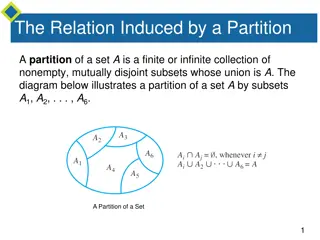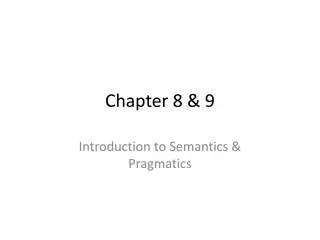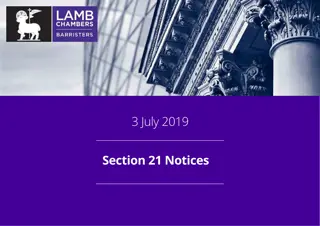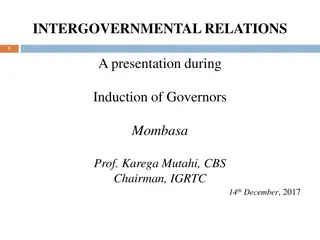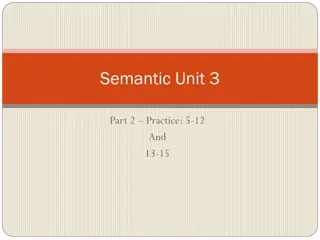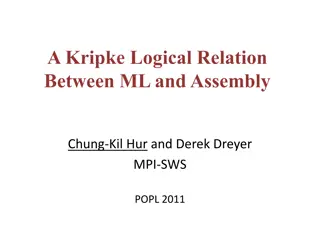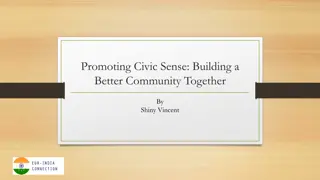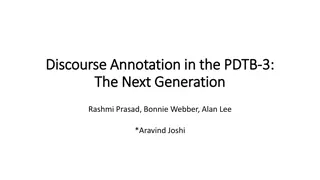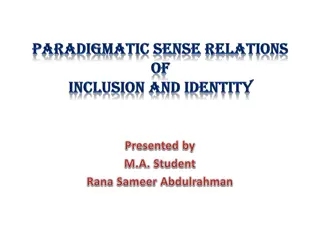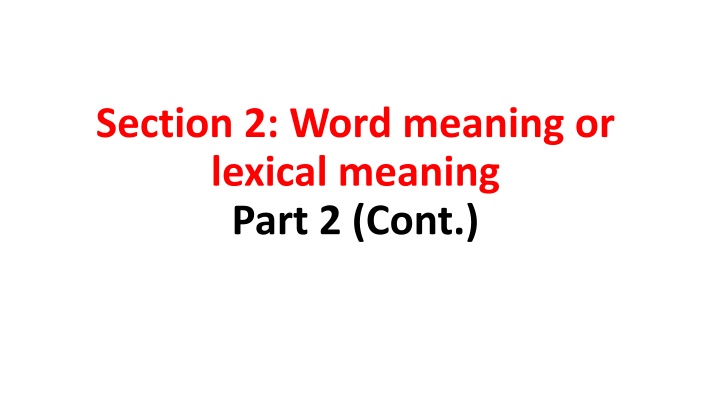
Word Relationships and Meanings in Language
Explore the concepts of hyponymy, synonymy, true synonymy, and partial synonymy in linguistics, illustrating how words relate to each other in terms of meaning and usage.
Download Presentation

Please find below an Image/Link to download the presentation.
The content on the website is provided AS IS for your information and personal use only. It may not be sold, licensed, or shared on other websites without obtaining consent from the author. If you encounter any issues during the download, it is possible that the publisher has removed the file from their server.
You are allowed to download the files provided on this website for personal or commercial use, subject to the condition that they are used lawfully. All files are the property of their respective owners.
The content on the website is provided AS IS for your information and personal use only. It may not be sold, licensed, or shared on other websites without obtaining consent from the author.
E N D
Presentation Transcript
Section 2: Word meaning or lexical meaning Part 2 (Cont.)
Sense relations/Semantics relationships 1. Hyponymy 2. Synonymy 3. Antonymy 4. Homonymy 5. Polysemy 6. Lexical ambiguity
Hyponymy Definition: Hyponymy is a relation in which the referent of a word is totally included in the referent of another word. In other words, hyponymy is the relationship between each of the hyponyms (the lower word) and its superordinate (the higher word):
Synonymy Synonymy is a relation in which various words have different (written and sound) forms but have the same or nearly the same meaning. Ex1: The two English verbs hide and conceal are synonyms; they both mean keep somebody/something from being seen or known about. Ex2: The four English nouns kind, type, sort and variety are synonyms; they all refer to a group having similar characteristics.
True synonymy There are few true synonyms in the lexicon of a language. Example 1: movie, film, flick and motion picture may be considered as synonyms because they have the same denotative meaning. However, these lexical items differ in their connotative meanings: - movie may strike you as American - film may strike you as British or as appropriate for movie classics or art movies; - flick is used chiefly in very informal contexts - motion picture is quaintly outdated flick n [C] (dated, informal) cinema film and has connotations as a term from the thirties or forties of the 20th century. In brief, movie, film, flick and motion picture are not true synonyms.
True synonymy Example 2: fast, quick and rapid may be considered as synonyms because they may be used interchangeably in: He s a fast/quick/rapid runner. However; - a fast talker: one who is able to get out of trouble by talking cleverly, - a quick talker: one who usually talks in a rapid manner; - OR He has a quick mind, not a rapid mind or a fast mind; - OR He gave her a quick glance, not a rapid glance or a fast glance. In brief, fast, quick and rapid are not true synonyms. Although true synonymy is rare, the notion is useful because it helps describe similarities between the meanings of different terms in the lexicon.
Partial synonymy Partial synonymy is a relation in which a polysemous word shares one of its meanings with another word. Example: (1a). You have my deep sympathy. (1b). You have my profound sympathy. (2a). The river is very deep at this point. (2)b. *The river is very profound at this point. Partial synonymy leads to collocations: a bunch of keys, a herd of sheep, a school of ants, a flock of birds, a group of teachers, a gang of thieves, etc.
Antonymy Definition: Antonymy is a relation in which two words have different (written and sound) forms and are opposite in meaning. Example: - pass--fail, hot--cold and thinner--fatter are three pairs of antonyms. - true--false, big--small and buy--sell are three pairs of antonyms. Classification - Binary antonymy - Gradable antonymy - Relational antonymy
Classification of Antonymy Binary antonymy is a relation in which two members of a pair of antonyms: - are mutually exclusive: not A is B: not alive is dead and not dead is alive. - cannot be used in a comparative or superlative sense: *He is more single/more married than his brother. - cannot be used in questions with how to ask about degrees: *How single/How married is he? alive--dead and married--single are two pairs of binary antonyms. The meaning of the word is absolute, not relative, there is no intermediate ground between two of them.
Classification of Antonymy Gradable antonymy is a relation in which two members of a pair of antonyms: - are gradable: between hot and cold are three intermediate terms warm, tepid (or lukewarm) and cool. - can be used in a comparative or superlative sense: wider is less narrow, more difficult is less easy, etc. - can be used in questions with how to ask about degrees: How difficult is the test? hot--cold and difficult--easy are two pairs of gradable antonyms. This type describes something which can be measured and compared with something else.
Gradable antonymy and (un)markedness Words that are in an antonymous relationship often do not have equal status with respect to markedness. In a pair of antonyms, one member is more unmarked and the other is more marked or one member is marked and the other is unmarked. The unmarked member is the one used in questions of degree.
Classification of Antonymy Relational antonymy: two members of a pair of relational antonyms display symmetry in their meaning. The if , then formula can be used to test and identify relational antonyms: - if Mr. Brown is Jack s employer, then Jack is Mr. Brown s employee; - if Jenny is thinner than Mary, then Mary is fatter than Jenny; - if John bought a car from Fred, then Fred sold a car to John; etc. Relational antonyms are also called converses: the pairs of words are the reversal of a relationship of words. Example: give receive , husband wife, above below
Homonymy Definition: Homonymy is a relation in which various words have the same (sound and written) form but have different meanings. Classified as three homonyms are : - the noun bear, which refers to a large heavy animal with thick fur, - the verb bear1, which means give birth to, - the verb bear2, which means tolerate; all being pronounced /be (r)/ in RP.
Homophony Homophony is a relation in which various words have the same sound form (also referred to as pronunciation) but have different meanings and written forms. Classified as two homophones are: the noun hour, which means a twenty-fourth part of a day and night, the possessive adjective our, which means belonging to us; both being pronounced / (r)/ in RP
Homography Homography is a relation in which various words have the same written form (also referred to as spelling) but have different meanings and sound forms. Classified as two homographs are: the bare infinitive form read /ri:d/ the past tense form read /red/.
Polysemy Definition: Polysemy is a relation in which a single word has two or more slightly different but closely related meanings. Example: The noun chip has the three following meanings: a small piece of some hard substance which has been broken off from something larger: a chip of wood/glass. a small cut piece of potato which is fried for eating: Can I try one of your chips? a small but vital piece of a computer: This computer has got a faster chip than the old one.
Ambiguity Lexical ambiguity Any ambiguity resulting from the ambiguity of a word is lexical ambiguity. Example 1: They were waiting at the bank in two different ways: - They were waiting at the financial institution. - They were waiting at the shore of the river. Example 2: That robot is bright in two different ways: - That robot is shining. - That robot is intelligent. Thus, both polysemy and homonymy contribute to lexical ambiguity.
Sense relations/Semantics relationships 1. Hyponymy 2. Synonymy 3. Antonymy - Binary antonymy - Gradable antonymy - Relatonal antonymy 4. Homonymy - Homophony (phone/phoneme) - Homography (graph) 5. Polysemy 6. Lexical ambiguity
What is the relationship between the words in the following pairs? 1. permit allow 2. lead (v) lead (n) 3. sheep ram 4. teach learn 5. strong weak 6. feat feet 7. accept refuse 8. cup (drinking vessel) cup (an ornamental trophy) 9. kids - children 10.bark (of a dog) bark (of a tree) 11.host guest 12.row (a quarrel) row (a line) 13.postpone delay 14.flour flower 15.clever stupid 16.walk - tiptoe 17.pass fail 18.happy pleased 19.well (adv) well (n) 20.fork (in a road) fork (instrument for eating)
Mini test What is the relationship between the words in the following pairs? 1. permit allow 2. lead (v) lead (n) 3. sheep ram 4. teach learn 5. big small 6. feat feet 7. accept refuse 8. fair (n) fair (a) 9. kids - children 10. bark (of a dog) bark (of a tree)
Mini test What is the relationship between the words in the following pairs? 1. permit allow 2. lead (v) lead (n) 3. sheep ram 4. teach learn 5. strong weak 6. feat feet 7. accept refuse 8. cup (drinking vessel) cup (an ornamental trophy) 9. kids - children 10. bark (of a dog) bark (of a tree)
Mini test What is the relationship between the words in the following pairs? 1. host guest 2. row (a quarrel) row (a line) 3. postpone delay 4. flour flower 5. clever stupid 6. walk - tiptoe 7. pass fail 8. happy pleased 9. well (adv) well (n) 10. fork (in a road) fork (instrument for eating)


